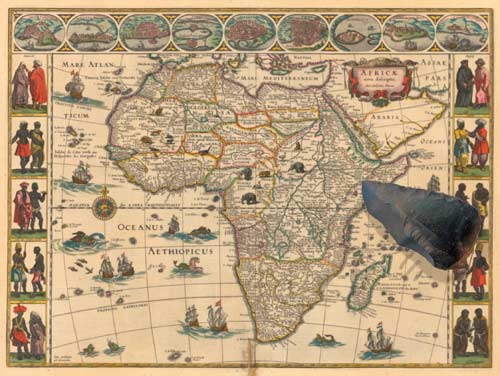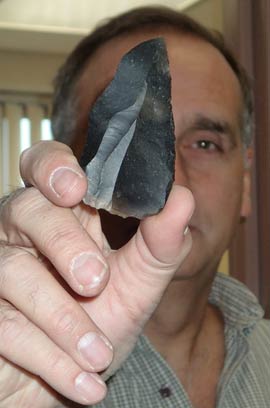
A flint spearpoint marks the spot where researchers made a surprising discovery of Stone Age technological advancement.
In the life of a Paleolithic hunter from over 250,000 years ago, the ability to take down prey—or a threatening predator—from a distance would have been a vast improvement over confronting a dangerous animal at close quarters. New research by Dr. Karl Hutchings and others finds evidence that these early hunters, predating modern humans, developed the technology to do so far earlier than first thought.
“The use of composite tools (those incorporating multiple material types) for hunting from a distance represents a remarkable evolutionary advancement in human cognition,” says Hutchings, assistant professor of archaeology in TRU’s Department of Sociology and Anthropology.
At least 400,000 years ago, he explains, Homo erectus hunters in Europe made sharpened wooden spears, as did their descendants the Neanderthals during the later Ice Age. Evidence suggests these hunters thrust the spears directly into their prey while dodging a variety of horns, hooves, claws or teeth.
“The fossilized bones of Neanderthals commonly document the physical trauma suffered from close and violent encounters with big game,” says Hutchings. “Meanwhile, far south of the Pleistocene ice sheets, humans continued to evolve both physically and culturally, and they developed more effective technologies.
“They began to combine the best features of multiple materials, like the sharpness of stone, the durability of wood, and the use of bindings and glue to hold it all together, in order to make better weaponry and tools. And they learned to protect themselves by hunting from a distance.”
Sometime before the invention of mechanically-projected weapons like the bow-and-arrow around 50,000 to 100,000 years ago, humans developed the throwing spear or javelin, adding a stone tip. Modern Homo sapiens were credited with this advancement, because there had been no conclusive evidence of throwing spears being used more than 80,000 years ago.
For this research, Hutchings applied his expertise in the analysis of stone weapon tips to measure the forces that caused them to break in antiquity. He analyzed obsidian spear tips the researchers recovered from the Gademotta Formation, a Middle Stone Age archaeological site in the Main Ethiopian Rift Valley in East Africa, to determine whether the weapons were thrust or thrown by calculating the force of the impacts.
Using formulae and processes Hutchings developed for calculating fracture velocity, the researchers report that these later Middle Pleistocene obsidian tips had microfractures from throwing, rather than thrusting, providing evidence that hominins (perhaps predating modern humans) were using this projectile weaponry as early as 279,000 years ago.
“They began to combine the best features of multiple materials, like the sharpness of stone, the durability of wood, and the use of bindings and glue to hold it all together, in order to make better weaponry and tools. And they learned to protect themselves by hunting from a distance.”
—Dr. Karl HutchingsRead the research, published in the open access peer-reviewed journal PLOS One:
Earliest Stone-Tipped Projectiles from the Ethiopian Rift Date to >279,000 Years Ago
“This is merely the early stages of this research,” says Hutchings. “I plan to continue looking for further advances in Stone Age weaponry (earliest spear-throwers, earliest bow-and-arrow technology, etc.), and document the spread of these technologies.”
This study also discusses how this complex technological advancement may have helped Homo sapiens’ ancestors compete with Homo neanderthalensis and spread beyond Africa. It’s a key piece of the puzzle in the larger picture of the evolution of modern humans.
Hutchings’ research was also featured on National Geographic’s Daily News site:
“Oldest Javelins Predate Modern Humans, Raise Questions on Evolution“
Contact:
Dr. Karl Hutchings
Assistant Professor, Sociology & Anthropology
Thompson Rivers University
Tel: 250.371.5767
khutchings@tru.ca


